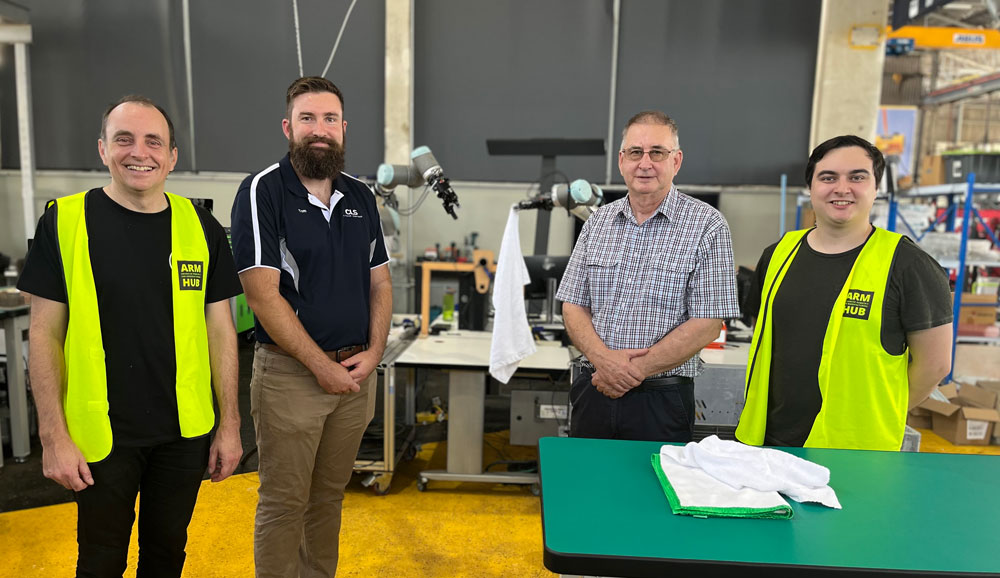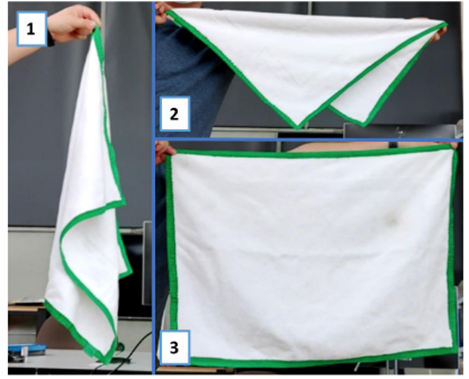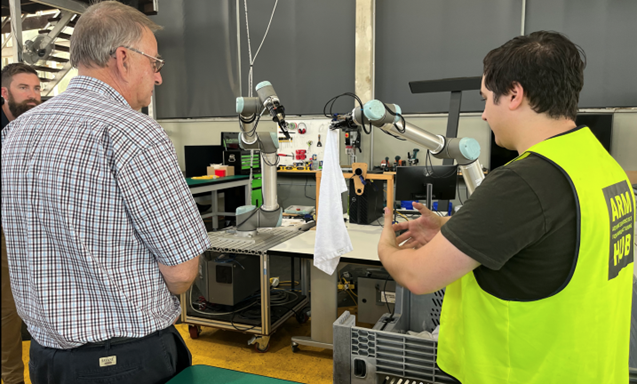A Queensland family-run laundry aims to develop a world-first automation system for one of the most labour-intensive tasks in commercial laundries – picking up, flattening, and feeding clean towels into an automated folding machine, before they are returned to the customer.

ARM Hub’s Prof Jonathon Roberts (left), Tom Roberts, CLS; Neville Roberts, CLS; and David Hedger, ARM Hub with the prototype towel flattening robot arms at the ARM Hub workshop in Brisbane
Each week, staff at Consolidated Linen Service’s (CLS) laundry operations feed by hand over 300 tonnes of clean linen into automated folding machines.
“It works out to around 700,000 individual textiles – towels, sheets, and pillowcases – every week,” says Tom Roberts, Operations Manager of the family run business based in Hervey Bay, which services an area of 1200kms across regional Queensland.
“The process is incredibly labour intensive – the item must be picked up individually from a hopper, held by the corners to flatten it, and then fed into the folding machine – which takes around six seconds per item.”
The work is undertaken in an environment that can get up to 50 degrees Celsius and around 95 percent relative humidity, requiring workers to take regular hydration and rest breaks.
In addition to occupational health and safety risks, the management of staff presents a major challenge, due to a mostly seasonal workforce.
Commercial laundries primarily service the hospitality industry, and the COVID-19 pandemic impacts were felt through the hospitality supply chain.
“With COVID, there were a lot of challenges and uncertainties, and we really had to look at ways of that we could adapt and become more agile in the laundry industry, otherwise there was a potential that we could not survive,” Tom said.
“There currently is no commercially available solution that can automatically flatten a towel (or any item) to then be fed into a towel folding machine for a commercial laundry – it simply does not exist on the market.”
CLS wanted to change that.
Neville Roberts, Tom’s father, who along with wife Morena, founded CLS 30 years ago, said the company had to keep up with pace and be able to manufacture.
“With the Olympics in 2032, the hospitality industry in Queensland is going to grow massively over the next 10 to 15 years,” Neville said.
“Thirty years ago, laundry was 30 tonnes per week and now you are talking hundreds of tonnes per week, so to take it to the next level and try and cater for the growing market, there is only one way we can do it, and that is automation.
“Ultimately we want to improve efficiency and safety throughout the laundry while improving our business profitability at the same time.”
With funding from the Queensland Government’s Essential Goods and Supply Chain Program, CLS began working with Professor Jonathan Roberts, Technical Director at ARM Hub and Director of the Australian Cobotics Centre; and Ms Amelia Luu, Megatronics Engineer at ARM Hub and David Ledger, Head of Project Services at ARM Hub, to develop an automated solution to the towel flattening problem.
David said the first phase of the project aimed to demonstrate it was possible to automate flattening an item like a towel.
“We focused on towels initially, as linens are generally more difficult to handle,” he said.
“We observed that when a towel was hung up by a corner, the opposite corner would usually be at the lowest point.

“When these two corners were grasped and stretched apart horizontally, the remaining two corners would usually hang at the new lowest point, either one of which could now be grabbed to end up with two adjacent corners.”
A prototype system was assembled to take advantage of these properties.
“We laid the towel flat on a table and developed software for a single robot arm to perform the steps without needing two arms,” David said.
This method proved relatively reliable, even with minimal sensing input, however, it did require a large amount of workspace.
“There was a throughput limit due to the necessary stretching of the towels and large movement distances, and there were other issues,” David said.
Given the ARM Hub team developed the initial prototype relatively quickly, there was still project time available to investigate other options.
“We presented the client with a set of options: either continue development of this table-based system until it is commercially viable,” David said.
“Or we could develop the table-based system with custom robotic hardware to optimise the workspace and maximise throughput; or, thirdly, we could try to develop a method that relied on advanced AI technologies like computer vision, with a goal of maximising the throughput potential of the design, with the associated high-risk and low-commercial readiness.”
CLS chose the high-tech latter option.
The ARM Hub project team then carried out a site visit to CLS’s Hervey Bay laundry and recorded data on the laundry and the working environment, developing 3D models of the workspace.
Work then commenced on a second prototype – this one with two robotic arms to pick up and unfold the towels.
The arms were mounted on tables at a distance that enabled overlapping ranges of motion and operated at a limited speed to ensure safety.
A container (hopper) half-filled with white towels supplied by CLS was placed next to one of the robot arms.
The towels used in this project varied slightly in size but were all within 20 percent of the towel size used for training the computer vision system.
“The vision system is capable of detecting corners on towels of greater size, but the robotic system would not accommodate anything much larger due to workspace layout and planning constraints,” David said.
One camera is mounted on a table between the two arms facing the area that both arms can reach, where towels are unfolded. The other camera is mounted on the corner of the hopper, looking down into it.
One arm reaches down to retrieve a towel and then presents it in such a position that it is visible to the camera and reachable by the other arm.

The cameras combine an RGB camera and 3D LIDAR sensor, generating an image with both RGB and depth information for each pixel to enable furthest point detection and corner detection.
Labelled data was obtained by painting the edges of a white towel in green and using the discarded RGB data to generate a mask of “real” versus folded edges.

The model was then trained for several days, testing a variety of kernel sizes, number of layers, learning rates, and augmentation techniques for the best results.
The system is coordinated by the scheduler node, which runs through a sequence of actions determined by the current system state. These actions include collecting and processing camera images, moving the robot arms to various waypoints, and actuating the grippers.
David said the aim of the project was to prove out the viability of a computer vision driven, bi-manual towel unfolding concept.
“This goal was achieved with great success,” he said.
“There are clear pathways for increasing the throughput and accuracy of the system, and no hard barriers to scale were discovered.”
The ARM Hub team are planning a follow-on project to deploy an optimised system on site at CLS’s operations in Hervey Bay.
The next phase of the project will focus on integrating the system with the folding machines used by CLS in their laundries, and will require the addition of towel re-feeding systems, industrial communication protocols, and additional checking for unsupported towels.
“With hardware specified for the task and extra computer vision engineering effort, we should be able to push the performance into the range where it is attractive to potential customers,” David said.
“As far as we can tell, this technique and its scalability is unique in the laundry space, and there is a significant commercial opportunity should it be pursued further.”
For Neville and Tom Roberts, the innovation would be a world-first and help their sector become more resilient to economic impacts from tourism and labour availability, such as was experienced during the COVID-19 pandemic.
“David and the team at ARM Hub have been just fantastic to deal with,” Tom said.
“They’ve always had an open mind when other places said what we were trying to do could not be achieved and so we have always gone in with that mindset and tried so many different options and ways of trying to tackle the problem and so their willingness to come to the table and help and to throw ideas around has been fantastic and we wouldn’t have been here without them.”
More information: Contact ARM Hub – info@armhub.com.au